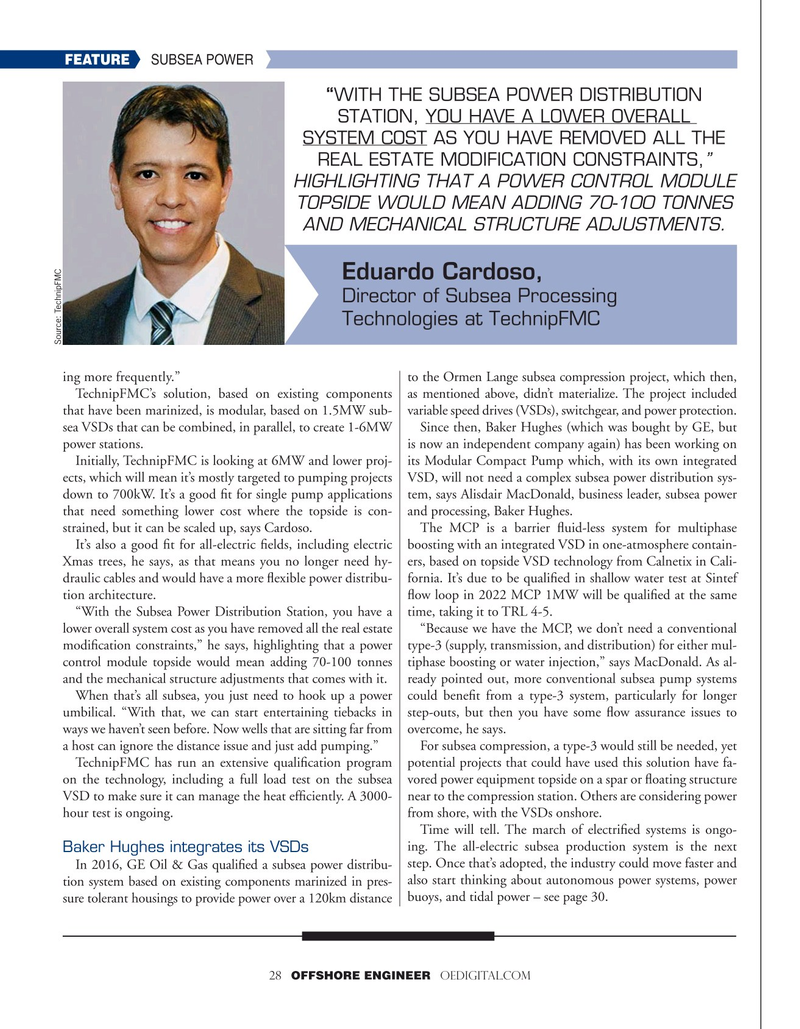
Page 28: of Offshore Engineer Magazine (Nov/Dec 2020)
Read this page in Pdf, Flash or Html5 edition of Nov/Dec 2020 Offshore Engineer Magazine
FEATURE SUBSEA POWER “WITH THE SUBSEA POWER DISTRIBUTION
STATION, YOU HAVE A LOWER OVERALL
SYSTEM COST AS YOU HAVE REMOVED ALL THE
REAL ESTATE MODIFICATION CONSTRAINTS,”
HIGHLIGHTING THAT A POWER CONTROL MODULE
TOPSIDE WOULD MEAN ADDING 70-100 TONNES
AND MECHANICAL STRUCTURE ADJUSTMENTS.
Eduardo Cardoso,
Director of Subsea Processing
Technologies at TechnipFMC
Source: TechnipFMC ing more frequently.” to the Ormen Lange subsea compression project, which then,
TechnipFMC’s solution, based on existing components as mentioned above, didn’t materialize. The project included that have been marinized, is modular, based on 1.5MW sub- variable speed drives (VSDs), switchgear, and power protection. sea VSDs that can be combined, in parallel, to create 1-6MW Since then, Baker Hughes (which was bought by GE, but power stations. is now an independent company again) has been working on
Initially, TechnipFMC is looking at 6MW and lower proj- its Modular Compact Pump which, with its own integrated ects, which will mean it’s mostly targeted to pumping projects VSD, will not need a complex subsea power distribution sys- down to 700kW. It’s a good ?t for single pump applications tem, says Alisdair MacDonald, business leader, subsea power that need something lower cost where the topside is con- and processing, Baker Hughes. strained, but it can be scaled up, says Cardoso. The MCP is a barrier ?uid-less system for multiphase
It’s also a good ?t for all-electric ?elds, including electric boosting with an integrated VSD in one-atmosphere contain-
Xmas trees, he says, as that means you no longer need hy- ers, based on topside VSD technology from Calnetix in Cali- draulic cables and would have a more ?exible power distribu- fornia. It’s due to be quali?ed in shallow water test at Sintef tion architecture. ?ow loop in 2022 MCP 1MW will be quali?ed at the same “With the Subsea Power Distribution Station, you have a time, taking it to TRL 4-5. lower overall system cost as you have removed all the real estate “Because we have the MCP, we don’t need a conventional modi?cation constraints,” he says, highlighting that a power type-3 (supply, transmission, and distribution) for either mul- control module topside would mean adding 70-100 tonnes tiphase boosting or water injection,” says MacDonald. As al- and the mechanical structure adjustments that comes with it. ready pointed out, more conventional subsea pump systems
When that’s all subsea, you just need to hook up a power could bene?t from a type-3 system, particularly for longer umbilical. “With that, we can start entertaining tiebacks in step-outs, but then you have some ?ow assurance issues to ways we haven’t seen before. Now wells that are sitting far from overcome, he says. a host can ignore the distance issue and just add pumping.” For subsea compression, a type-3 would still be needed, yet
TechnipFMC has run an extensive quali?cation program potential projects that could have used this solution have fa- on the technology, including a full load test on the subsea vored power equipment topside on a spar or ?oating structure
VSD to make sure it can manage the heat ef?ciently. A 3000- near to the compression station. Others are considering power hour test is ongoing. from shore, with the VSDs onshore.
Time will tell. The march of electri?ed systems is ongo- ing. The all-electric subsea production system is the next
Baker Hughes integrates its VSDs step. Once that’s adopted, the industry could move faster and
In 2016, GE Oil & Gas quali?ed a subsea power distribu- also start thinking about autonomous power systems, power tion system based on existing components marinized in pres- sure tolerant housings to provide power over a 120km distance buoys, and tidal power – see page 30. 28 OFFSHORE ENGINEER OEDIGITAL.COM

 27
27

 29
29